
table of contents
- Why impregnate?
- Impregnating agent
- paint
- glaze
- Oils
- Oily home remedies
- Basics of impregnation
- Prepare
- Applying the impregnating agent
- dry
- Apply second layer
- frequently asked Questions
Garden furniture and other wooden elements give the garden an extremely natural appearance. However, many garden owners shy away from the natural material, as many types of wood have to be made weatherproof on a regular basis.
In a nutshell
- Wood impregnation basics include cleaning, applying, and drying
- only use impregnating agents for outdoor use
- a second layer often increases protection
Why impregnate?
In the garden, garden furniture, fences or small wooden huts are very different in this country Exposed to the elements, such as moisture, heat and also in the case of wooden huts and fences Frost. You can also Pests and molds settle in the wood, so that in the worst case the natural material becomes rotten and collapses.
You should therefore protect garden furniture and other wooden elements in your garden from these dangers. Not only do they extend their lifespan, but with the appropriate care you also maintain their appearance, because an impregnation serves to keep the material
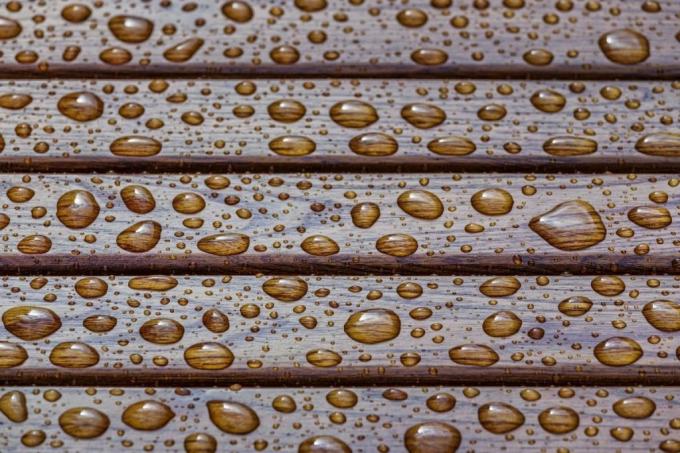
- water repellent and
- weatherproof
close. It also protects the wood from
- UV rays,
- Dehydration,
- insects and
- Mold.
Impregnating agent
There are various means of impregnating wooden elements. When choosing the right impregnating agent, it helps if you are guided by whether you are dealing with wood that will remain outdoors all year round (e. (E.g. garden fence) or is only exposed to wind and weather at a certain time of the year, such as garden furniture that is cleared in autumn.
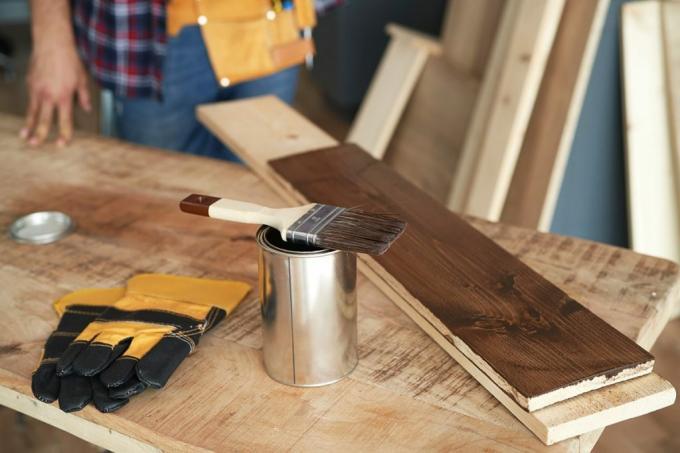
Furthermore, you should only use products that are intended for outdoor use. Because means for inside do not meet the requirements for outside. In addition, dark coatings protect the wood better against UV light, as they allow a lower proportion of the rays to pass through than light ones.
paint
Lacquers keep water away from the wood surface because it is covered with a thin layer of lacquer when it is lacquered. Among the different types of varnish is the so-called. Wood protection varnish is a very good choice to make the wood weatherproof. However, you have to expect that this paintwork will peel off over time, especially when exposed to permanent sunlight. Nonetheless, the impregnation with high-quality lacquers lasts longer than with glazes, as long as the lacquer layer does not get scratched.
Tip: A boat varnish offers even better protection, as it protects boat hulls from water. The disadvantage of this type of varnish, however, is that the natural wood look is very much changed.
glaze
In contrast to impregnation with varnish, the protection during glazing is not based on an outer layer, but takes place from the inside, as glazes penetrate deep into the wood. The advantages of a glaze are:
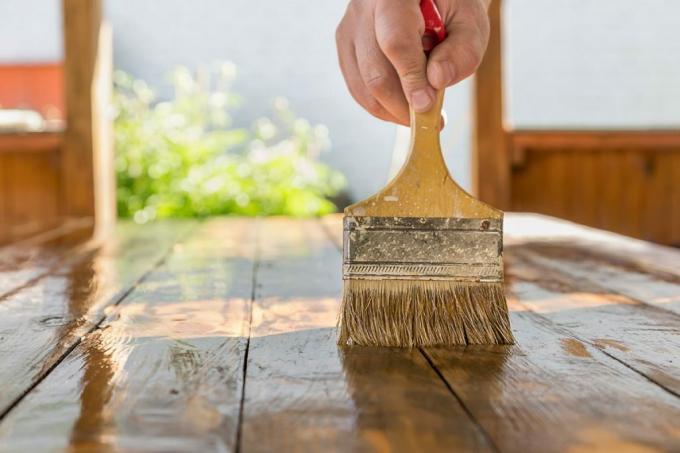
- long-term and high wood protection
- particularly weather-resistant
- The grain is retained
- no tendency to flake
- Thin-layer glaze ideal for garden furniture, wooden fences or window frames (deep penetration and protection from the inside)
- is particularly recommended for soft woods
Tip: If the material is raw, untreated, a previous primer is recommended. Because this ensures better adhesion of the subsequent layers.
Oils
Impregnation with oils has the following advantages:
- The wood grain is retained and emerges
- penetrates deep inside
- Material remains breathable (no clogging of the pores)
- Penetrated moisture can easily be released (increased resistance to mold and graying)
- natural feel of the surface
- for all Types of wood suitable
- colorless (natural) or available in natural colors
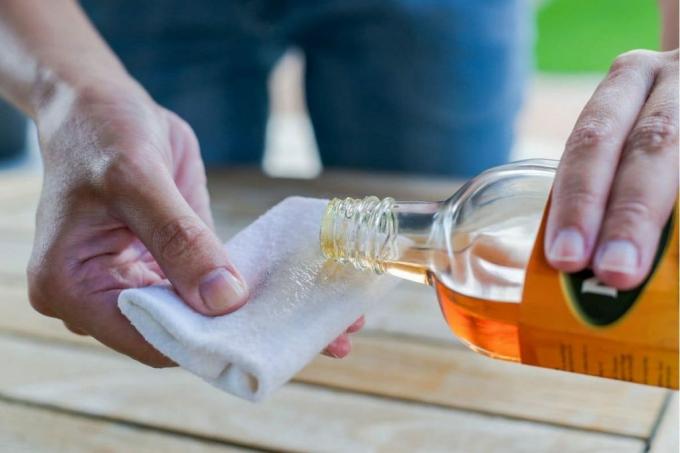
How often a year you should oil the wooden surface depends on how much it is used. For wooden table tops, for example, it is advisable to oil them two to three times a calendar year. However, it is advisable to apply the oil protection once a year, ideally in spring (garden furniture) and in autumn (garden fence or hut).
Tip: If the wood surface feels rough, an oil treatment is necessary in any case.
Oily home remedies
Natural oils without chemical additives are also suitable for making the natural raw material weatherproof. However, they do not seal completely. Therefore, the home remedies must be applied at shorter intervals.
linseed oil
Among the natural oils, linseed oil is the all-rounder, as it is not only tried and tested, but can also be applied to sensitive woods. However, you should not use anything other than a high-quality product for impregnation.
Tip: The outside temperature should be at least 15 degrees Celsius so that the linseed oil is absorbed well into the wood. 20 degrees Celsius or more are ideal.

olive oil
Since olive oil does not penetrate the wood as well, it is mixed with lemon juice. Because the citric acid ensures that the oil can penetrate faster. In addition, the juice dampens the odor of the olive oil, which some find unpleasant. To make the mixture, proceed as follows:
- Put 3 parts of olive oil with 1 part of lemon juice in a spray bottle
- shake well
Tip: An alternative is a mixture of vinegar essence with sunflower or olive oil.
Basics of impregnation
When impregnating garden furniture or wooden elements in the garden, the following three to four steps are essential:
- Prepare (clean and sand)
- Applying the impregnating agent
- dry
- possibly. Apply second layer (increases protection) and allow to dry
Prepare
Good preparation is one of the basics of impregnating wood. Because this can only develop its full effect if it can move in evenly in all places. Therefore, the wood must be cleaned, stripped of old paint and roughened before impregnation.
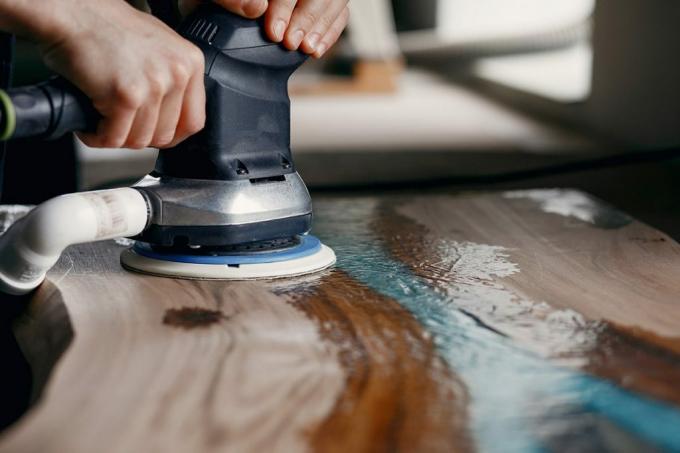
cleaning
It is best to use soapy water and a textile (cloth or sponge) for cleaning. Proceed as follows:
- Soak the textile in the soapy water and wring it out well
- Thoroughly wipe wooden surfaces
- Wipe the wood dry with another cloth
- let it dry in the fresh air as well
Note: To ensure that no moisture is trapped during subsequent impregnation, the wood must be completely dry before roughening.
Remove old paint and roughen it
Old varnishes and paints form a barrier through which the impregnating agent cannot penetrate. Therefore these old paints have to be removed. The use of a hairdryer and spatula is helpful because these tools make it easier to get the paint off. Thereafter
- Roughen the wood with sandpaper
- always sand in the direction of the grain
The final step of preparation is to remove the surface from
- Remnants of the sandpaper as well
- Wood dust
to free. If residues and dust remain on the wood, they mix with the impregnation agent, which is not only noticeable visually, but also reduces the protection.
Applying the impregnating agent
You should choose a dry day to apply the waterproofing agent. Since direct sunlight tends to cause stains, you should stay in the shade or under a roof or a cover work.
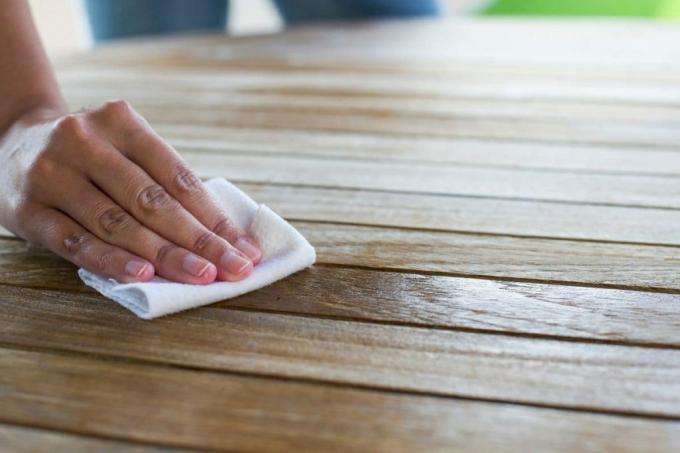
You should also mask off all areas and areas that are not to be impregnated in order to avoid unsightly stains. For the same reason, you should also protect the floor with cardboard or newspaper. Before you get down to work, you need to choose the right application tool. In general, the following applies here:
- Plastic bristles for water-based impregnating agents
- Natural bristles for solvent-based impregnations
- Textile cloth or sponge without steel wool for oils
When applying, proceed as follows:
- Apply or apply impregnating agent from top to bottom in the direction of the fibers. incorporate
- Use a narrower brush for edges and hard-to-reach areas
Note: In the case of self-made mixtures of lemon juice or vinegar essence and olive or Sunflower oil is sprayed with the emulsion on the surface of the wood.
dry
Once the first layer of the impregnating agent has been applied, it must dry or move in with oils and glazes. Wiping off runners or drops is done at

- Glazes after about ten minutes
- Oil after about five to ten minutes (drops)
The drying times also vary depending on the agent chosen. If you are impregnating with oil, you should plan for 24. If it concerns garden furniture, you should rather wait two days so that there are no stains on cushions or clothing. Oily home remedies should have been used
- Dry linseed oil for about 24 hours
- pure olive oil about 48 hours
Apply second layer
To increase protection, you can apply a second coat. However, the first one has to be well, but not completely dry beforehand. In the case of glazes, it is advisable to slightly roughen the material with sandpaper before treating it again. As with the first coat, you should wipe off any drops and rugs after application and then allow the wood to dry.
frequently asked Questions
Waxes offer the least protection of the impregnating agents. However, if the wax is applied to linseed oil, it creates a shiny surface.
A microfiber cloth is not suitable for applying an oil impregnation, as it removes oil from the wood. A brush or a lint-free cotton cloth is ideal.
The types of wood that are extremely weatherproof include Douglas fir, larch, robinia and teak. Also will bamboo, which actually belongs to the sweet grasses, is one of them. These Woods despite the weather, they turn gray over the years without care.



